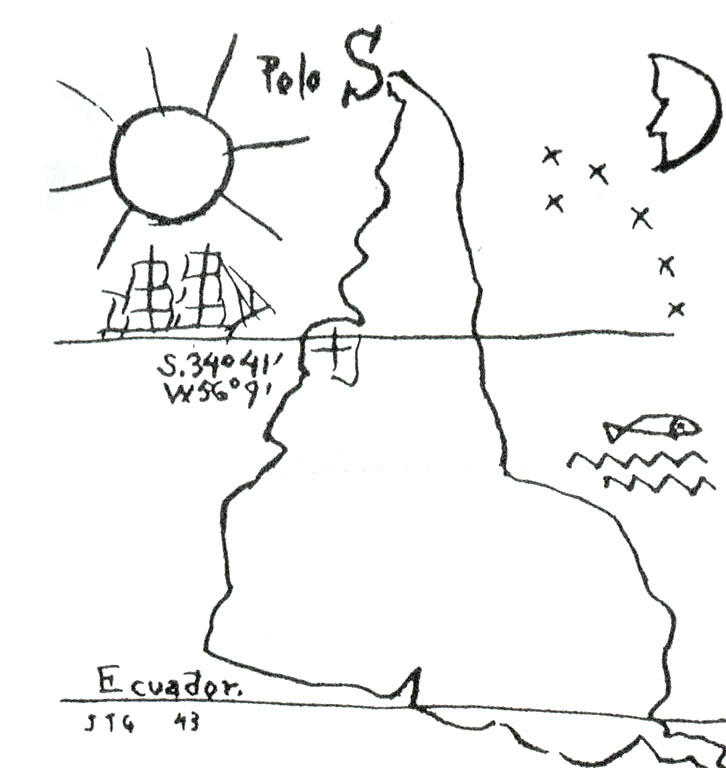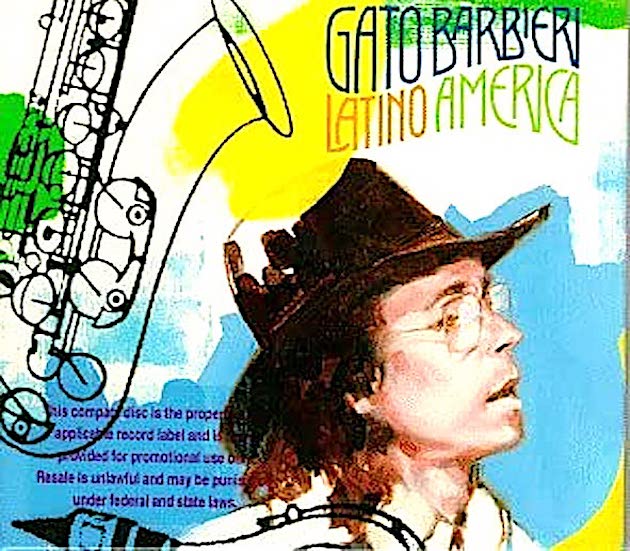On Gato
Barbieri's Latino America
On Gato
Barbieri's Latino America
Lenadro "Gato" Barbieri の1973 年のアルバムに "Chapter One: Latin America"がある。なぜ、彼(Gato Barbieri, 1932-2016)は、自分のアルバムのサブタイトルに英語のラテンアメリカを付けたのか?そこからこの物語がはじまる。
ラテンアメリカという概念については、日本文化人類学会での井上大 介との発表で「クロノトポスとしてのラテンアメリカ」 として、我々の考えを示しておいた。そこでの主張は「ラテンアメリカという用語と概念が、イスパノア メリカ(や対概念とされるアングロアメリカ)と並んで、政治的あるいは地政学的概念であ り、文化的中立性などを担保することができないことを証明(ないし は主張)するために作られたものである」ことを示した。



"Chapter One:
Latin America," 1973 and América
Invertida (1943)
だが、凡庸な我が国のラテンアメリカ「研究者」 諸君は、ラテンアメリカの「本質的な内実」を疑うことなく、この地域や文化的特質 を「愛する」と いう、個人的な趣味に基づき、学問的なその意味を考えることを後手後 手にしている感は否めない。ラテンアメリカとはその地域を「愛し」独特の感覚をもつ研 究者にとって、いったいどんな地域なのか、そのことを明確にしなければ、「地域研究」 というそのものは、相変わらず「地政学的まなざし」の圏外から逃れる ことはできない。
まずは、Chapter One についてウィキペディアからの情報である
| Chapter
One: Latin
America is a 1973 album by Gato Barbieri. It was recorded and
issued in
1973 on Impulse! Records as AS-9248. The album was re-released in 1997
as part of Latino America, a double CD that also included the album
Chapter Two: Hasta Siempre along with unreleased tracks.[2] In Creem magazine, Robert Christgau said like Barbieri's previous album Bolivia, Chapter One: Latin America is a "recommended introduction to the only jazzman this side of Miles Davis to translate avant-garde into semi-popular without sounding venal".[3] The Allmusic review awarded the album 4½ stars stating "this album, like its remaining chapters, makes up one of the great all but forgotten masterpieces in 1970s jazz".[4] "Encuentros" 12:28 "India" 8:58 "La China Leoncia Arreo La Correntinada Trajo Entre La Muchachada La Flor De La Juventud" 13:33 Part 1 2:28 Part 2 2:45 Part 3 4:32 Part 4 3:53 "Nunca Mas" 5:25 "To Be Continued" 2:27 All songs by Gato Barbieri, except India by J. Asunción Flores / M. Ortiz Guerrero. Gato Barbieri - tenor saxophone (1-5) Raul Mercado - quena (1, 2, 3) Amadeo Monges - Indian harp (1, 2, 3) Ricardo Lew - Electric guitar (1, 3) Quelo Palacios - acoustic guitar (1, 2, 3) Isoca Fumero - charango (1, 3) Antonio Pantoja - anapa, erke, siku, quena, erkencho (1, 2, 3) Adalberto Cevasco - Fender bass (1, 2, 3, 4) Dino Saluzzi - bandoneon (4) Domingo Cura - bombo indio (Indian drums) (1, 2, 3) Pocho Lapouble - drums (1, 3) Jorge Padin - percussion (1, 3) El Zurdo Roizner - percussion (1, 2, 3) Osvaldo Bellingieri - piano (4) Billboard Oct 13, 1973 Latino America at AllMusic Christgau, Robert (March 1974). "The Christgau Consumer Guide". Creem. Retrieved May 29, 2016. Allmusic Review accessed 3 November 2009 Swenson, J., ed. (1985). The Rolling Stone Jazz Record Guide. USA: Random House/Rolling Stone. pp. 19. ISBN 0-394-72643-X. Cook, Richard; Brian Morton (2008). The Penguin Guide to Jazz Recordings. The Penguin Guide to Jazz (9th ed.). London: Penguin. p. 79. ISBN 978-0-14-103401-0. |
『チャ
プター・ワン』("Chapter One: Latin
America")は、ガトー・バルビエリのアルバム。副題は『ラテンアメリカ』。1973年に南米(ブエノスアイレス,
リオデジャネイロ)で録音され、同年にImpulse!よりリリース。本作と次作『チャプター・トゥー』の全収録曲に未発表音源を加えた2枚組のコンピ
レーション盤『Latino America』が、1997年にリリースされた。[3] Creem誌において、ロバート・クリストガウは「バルビエリの前作『ボリビア』同様、商業主義に迎合することなくアバンギャルドを半大衆向けに読み替え て見せたマイルス・デイビスを筆頭とした数少ないジャズマン達による作品の一つとして、本作は推薦できる。」と評している。[4] オールミュージックのレビューは、「本作はタイトルが示すように、1970年代ジャズの偉大だが忘れられた傑作の中の一枚である。」として4つ星半の評価 を与えている。[5] ++++++++++++++++++++++++++++++++++++++ ガト・バルビエリ伝記 リチャード・S・ジネル著 ++++++++++++++++++++++++++++++++++++++ ガト・バルビエリは、現代ジャズに大きな影響を与えたアルゼンチン人ミュージシャンとしては二人目である。一人目はラロ・シフリンで、バルビエリはそのバ ンドで演奏していた。彼の経歴は、故郷と北米の間を長くジグザグに辿った旅路だ。若い頃は伝統的なラテンリズムを演奏していたが、60年代には自らのルー ツを捨ててジャズの前衛を探求し、70年代初頭には再び南米の影響を取り戻した。70年代後半にはポップやフュージョンを演奏したが、80年代には再び行 き来を繰り返した。北米の聴衆がバルビエリを初めて耳にした時、彼は荒々しい雄牛のように、ジョン・コルトレーンやファラオ・サンダースの影響を受けた荒 々しく悲鳴のようなトーンを響かせていた。しかし70年代半ばには、彼の演奏スタイルと音色は「ワット・ア・ディファレンス・ア・デイ・メイクス」(彼は これを古き良きボレロ「クアンド・ブエバ・ア・トゥ・ラド」として常に認識していた)やカルロス・サンタナの「ヨーロッパ」といったバラードに合わせて、 やや穏やかになり始めた。それでも、彼がどのジャンルで演奏しようとも、熱血漢のバルビエリは常にレコード史上最も感情を露わにするテナーサックス奏者の 一人であり、衝動的な声の掛け声で時折電圧をさらに高めることもあった。 坂を越えたエスカレーター バルビエリの家族には複数の音楽家がいたが、彼が楽器を手に取ったのは12歳の時だった。チャーリー・パーカーの「ナウズ・ザ・タイム」を聴いたことが きっかけでクラリネットの勉強を始めたのだ。1947年にブエノスアイレスへ移住すると、個人レッスンを続けながらアルトサックスを習得。1953年まで にシフリン・オーケストラでの活動を通じて、国内で著名な音楽家となっていた。50年代後半、バルビエリは自身のグループを率いるようになり、テナーサッ クスに転向した。1962年にイタリア生まれの妻と共にローマに移住した後、翌年にパリでドン・チェリーと出会い、彼のグループに参加してジャズ前衛に深 く没頭した。バルビエリは60年代後半にはマイク・マントラーのジャズ・コンポーザーズ・オーケストラでも演奏している。カーラ・ブレイの傑作『エスカ レーター・オーバー・ザ・ヒル』収録の「ホテル・序曲」では、彼の激しいトーンが解き放たれているのが聴ける。 エル・パンペロ しかし次の10年に入ると、バルビエリは徐々に心変わりし、南米のメロディ、楽器、ハーモニー、テクスチャー、リズムパターンを自らの音楽に取り入れ始め た。フライング・ダッチマンから発売されたライブ盤『エル・パンペロ』や、インパルス!レーベルの4部作『チャプター』シリーズ(後者はブラジルやアフ ロ・キューバのリズム・テクスチャーに加えアルゼンチン音楽も探求した)といったアルバムは、ジャズ界でバルビエリに高い評価をもたらし、アメリカの大学 キャンパスでも支持層を築いた。 ラスト・タンゴ・イン・パリ [オリジナル・モーション・ピクチャー・スコア] しかし、彼を国際的なスターとし、モントルー、ニューポート、ボローニャなどのフェスティバルで注目を集める存在にしたのは、1972年の問題作『ラスト タンゴ・イン・パリ』のための官能的な主題曲とスコアという商業的な偶然だった。アメリカのA&Mとの契約により、70年代後半にはソフトなポッ プ/ジャズアルバムの一連の作品が生まれた。その中には、売れ行きが好調だった『カリエンテ!』も含まれている。1981年にはプロデューサーのテオ・マ セロの監修のもと、ライブアルバム『ガトー…パラ・ロス・アミーゴス』でより強烈なロックの影響を受けた南米ルーツのサウンドへ回帰したが、その後『アパ シオナード』で再びポップ/ジャズ路線へ戻った。しかし1980年代後半、保守的なネオ・バップ運動の台頭により、彼の米国での存在感は薄れた。 ケ・パサ 三重バイパス手術と、最も親しい音楽上の相談相手であった妻ミシェルの死による悲嘆に苛まれ、バルビエリは1990年代の大半を活動休止した。しかし 1997年に復帰し、ロサンゼルスでのプレイボーイ・ジャズ・フェスティバルでは、アイデアは限られていたものの、かつての情熱的な演奏のほとんどを再 現。コロンビアからやや味気ないアルバム『ケ・パサ』を録音した。1999年には『チェ・コラソン』が続いた。 シャドウ・オブ・ザ・キャット 21世紀に入ると、バルビエリの作品のコレクション盤や再発盤が次々と登場した。2002年にはピーク・レコードから新作アルバム『シャドウ・オブ・ザ・キャット』がリリースされた。彼は2016年4月、83歳でニューヨーク市にて死去した。 https://www.allmusic.com/artist/gato-barbieri-mn0000191680#biography |
| https://en.wikipedia.org/wiki/Chapter_One:_Latin_America |
https://bit.ly/3t6jUP1 |
●ガトー・バルビエリ(Lenadro "Gato" Barbieri, 1932-2016)
次に、バルビエリ自身に関する情報だ。
| Leandro "Gato"
Barbieri (28 November 1932 – 2 April 2016) was an Argentine jazz tenor
saxophonist who rose to fame during the free jazz movement in the 1960s
and is known for his Latin jazz recordings of the 1970s.[1] His
nickname, Gato, is Spanish for "cat".[2] Born to a family of musicians, Barbieri began playing music after hearing Charlie Parker's "Now's the Time". He played the clarinet and later the alto saxophone while performing with Argentine pianist Lalo Schifrin in the late 1950s. By the early 1960s, while playing in Rome, he also worked with the trumpeter Don Cherry. By now influenced by John Coltrane's late recordings, as well as those from other free jazz saxophonists such as Albert Ayler and Pharoah Sanders, he began to develop the warm and gritty tone with which he is associated. In the late 1960s, he was fusing music from South America into his playing and contributed to multi-artist projects like Charlie Haden's Liberation Music Orchestra and Carla Bley's Escalator Over The Hill. His score for Bernardo Bertolucci's 1972 film Last Tango in Paris earned him a Grammy Award and led to a record deal with Impulse! Records.[1][3][2][4] By the mid-1970s, he was recording for A&M Records and moved his music towards soul-jazz and jazz-pop. Caliente! (1976) included his best known song, a rendition of Carlos Santana's "Europa". That and the follow-up album, Ruby Ruby (1977) were both produced by fellow musician and label co-founder, Herb Alpert.[5] Although he continued to record and perform well into the 1980s, including composing the scores to films such as Firepower (1979) and Strangers Kiss (1983), the death of his wife Michelle led him to withdraw from the public arena. He returned to recording and performing in the late 1990s, composing original scores at the behest of friend Bahman Maghsoudlou for Amir Naderi's Manhattan by Numbers (1991) and Daryush Shokof's Seven Servants (1996). The album Qué Pasa (1997) moved more into the style of smooth jazz. Barbieri was the inspiration for the character Zoot in the fictional Muppet band Dr. Teeth and The Electric Mayhem.[6] On April 2, 2016, Barbieri died of pneumonia in New York City at the age of 83.[7] Gato Barbieri was among hundreds of artists whose material was destroyed in the 2008 Universal fire.[8] Discography, As leader In Search of the Mystery (ESP Disk, 1967) Obsession (Affinity, 1967, [1978]) Confluence (Freedom, 1968) with Dollar Brand – also released as Hamba Khale! (1974) and I Grandi del Jazz (1976) The Third World (Flying Dutchman, 1969) Fenix (Flying Dutchman, 1971) El Pampero (Flying Dutchman, 1971) Under Fire (Flying Dutchman, 1971 [1973]) Last Tango in Paris (United Artists, 1972) Bolivia (Flying Dutchman, 1973) Chapter One: Latin America (Impulse!, 1973) Chapter Two: Hasta Siempre (Impulse!, 1973) Chapter Three: Viva Emiliano Zapata (Impulse!, 1974) Yesterdays (Flying Dutchman, 1974) Chapter Four: Alive in New York (Impulse!, 1975) El Gato (1975 compilation) includes 1 previously unreleased track Caliente! (A&M, 1976) I Grandi del Jazz (1976) (Previously released as Confluence and Hamba Khale!) Ruby Ruby (1977) Tropico (1978) Euphoria (1979) Bahia (1982) Apasionado (1983) Para Los Amigos (1984) Passion And Fire (1988) The Third World Revisited (1988 compilation) Seven Servants (1996) Qué Pasa (1997) Che Corazón (1999) The Shadow of The Cat (2002) New York Meeting (2010) ++++++++++++++++++++++++++++++++++++++ Gato Barbieri, Latin Jazz Trailblazer With a Saxophone, Is Dead at 83, by The New York Times, By Peter Keepnews and Christopher Mele, April 2, 2016 "Gato Barbieri, a saxophonist whose highly emotional playing helped expand the audience for Latin jazz, and whose music for the film “Last Tango in Paris” won a Grammy Award, died on Saturday in New York. He was 83. His death was confirmed by Jordy Freed, the vice president for marketing and communications at the Blue Note Entertainment Group, parent company of the Blue Note nightclub in Greenwich Village, where Mr. Barbieri often performed. Mr. Barbieri’s wife, Laura, told The Associated Press that the cause was pneumonia. Mr. Barbieri recorded dozens of albums in a career that began in the late 1940s in his native Argentina, and continued recording and performing into the 21st century. Although he was heavily influenced by John Coltrane and other saxophonists, his big, lush sound was distinctly his own and instantly recognizable." |
年譜 バルビエリは、音楽一家に生まれたにもかかわらず、演奏とは無縁の幼少期を送っていた。ところが、12歳の時に聴いたチャーリー・パーカーの「Now's the Time」に衝撃を受け、クラリネットを演奏するようになった。1947年にはブエノス・アイレスに転居し、アルト・サックスに転向した。1953年にア ルゼンチン人のピアノ奏者であるラロ・シフリンのオーケストラに加入。シフリンの下で活動していた頃からテナー・サックスも併用し、1950年代後期には 自らのグループを率いるようになった。イタリア出身の女性ミシェルと結婚したことを機に、1962年にはイタリアのローマに活動の拠点を移した。ちなみ に、ミシェルは彼にガトーというニックネームを与えたその人であり、妻としてはもちろん、音楽的パートナーとしてもガトーを支えていくことになる。 1960年代 ローマ移住後にパリでトランペット奏者のドン・チェリーと出会う。時は1960年代。アルバート・アイラーやファラオ・サンダースといった他のフリー・ ジャズ・サックス奏者達と同様にジョン・コルトレーンの後期の作品に強い影響を受けつつも、暖かくザラついたトーンに代表される彼独自のスタイルを確立し つつあった。イタリアでは現地ミュージシャンの作品に客演し、1965年にはニューヨークに移住。ドン・チェリーのバンドに正式に加入し、数年間活動す る。 1967年には初のリーダー・アルバム『イン・サーチ・オブ・ザ・ミステリー』を発表し、翌年にはマイク・マントラーのジャズ・コンポーザーズ・オーケス トラに加入。これが後のチャーリー・ヘイデンの「Liberation Music Orchestra」やカーラ・ブレイの「Escalator Over The Hill」といった多人数ミュージシャンによるプロジェクトへの参加につながっていくことになる。 1970年代前期 1970年代に入ると、フリー・ジャズ一辺倒だった自らのスタイルを、 自身のルーツである南米音楽の要素を中心に据えたものに変化させていく。ボブ・シールのプロデュースによるフライング・ダッチマン時代の作品群は、まさに その成果と言える。ベルナルド・ベルトルッチの1972年の映画『ラストタンゴ・イン・パリ』で音楽監督を担当し、翌年にはグラミー賞を受賞[2]。彼は 一躍、国際的なスターにのし上がった。また、憧れのコルトレーンがかつて在籍したインパルス・レコードとの契約も実現した。エド・ミシェルのプロデュース によるインパルス時代の「Chapter四部作」は、大人数編成による意欲作であり、まさにガトーの全盛期を捉えた金字塔と言える。 1970年代後期 1976年にはA&Mレコードと契約し、音楽性をロック的な要素の強いポップなものに変化させていった。1976年の作品『カリエンテ!』にはカ ルロス・サンタナの「Europa」のカバーが収録されており、彼の代表演奏曲となっている。この作品とそれに続く1977年のアルバム『ルビー、ル ビー』でプロデュースを手掛けたのは、A&Mレコードの共同設立者であるハーブ・アルパートだった。A&M時代は、ジャズ・ポップ路線を 踏襲しつつ精力的にレコーディング活動と公演活動を続けた。 1980年代 1980年代は、ウィントン・マルサリスに代表される新伝承派の台頭によって、ガトーの活躍の場は徐々に減っていく。1981年にファニア・レコードに移 籍したが、リリースした作品は1枚のみにとどまった。1983年、ボブ・シールのドクター・ジャズ・レコードに移籍するも、アルバム『アパショナード』を 最後に目立った活動はなくなった。 1990年代 - 2000年代 1990年代になると活動を再開し、アミール・ナデリの『Manhattan by Numbers』(1991年)やダリューシュ・ショコフの『Seven Servants』(1996年)で映画製作総指揮を執っていた友人のバーマン・マグサウドロウの依頼で、それぞれの映画の音楽監督を担当した。ところ が、1995年に長年連れ添った妻のミシェルが死去。その数か月後には自身が心臓発作で倒れてしまう。それから1年以上の闘病生活を経た1997年、14 年ぶりの新作『Qué Pasa』をリリースした。このアルバムでは、そのスタイルをさらにスムーズ・ジャズに接近させている。その後2010年にかけて、ゆっくりとしたペース ではあるが、3枚のアルバムを残している。 2016年4月2日 ニューヨークにて肺炎のため死去。83歳 ++++++++++++++++++++++++++++++++++++++ ガトー・バルビエリ、ラテンジャズの先駆者、サックス奏者、83歳で死去、ニューヨーク・タイムズ紙、 ピーター・キープニュースとクリストファー・メレ、2016年4月2日 ガトー・バルビエリは、感情豊かな演奏でラテン・ジャズの聴衆層を広げ、映画『ラストタンゴ・イン・パリ』の音楽でグラミー賞を受賞したサックス奏者であ る。彼は土曜日にニューヨークで死去した。83歳だった。死はブルーノート・エンターテインメント・グループのマーケティング・コミュニケーション担当副 社長、ジョーディ・フリードによって確認された。同社はバルビエリ氏が頻繁に演奏したグリニッジ・ビレッジのブルーノート・ナイトクラブの親会社である。 妻のローラ氏はAP通信に対し、死因は肺炎だと語った。バルビエリ氏は1940年代後半に母国アルゼンチンでキャリアをスタートさせ、21世紀に入っても 録音と演奏を続けた。数十枚のアルバムを録音した。ジョン・コルトレーンらサックス奏者に強く影響を受けつつも、豊かで力強い音色は彼独自のもので、一聴 して彼とわかるものだった。」 |
| https://en.wikipedia.org/wiki/Gato_Barbieri |
https://bit.ly/3HCQADR |
"Leandro “Gato” Barbieri (Rosario, 28 de noviembre de 1932-Nueva York, 2 de abril de 2016)1fue un saxofonista de jazz argentino. Representante destacado del jazz latino, participó en su juventud en la banda de otro destacado jazzista argentino, Lalo Schifrin. Abordó también en su carrera el jazz de vanguardia, sobre todo en la década de 1960, así como el pop y la fusión a finales de la década de 1970. Fue influido por John Coltrane, Pharoah Sanders y Carlos Santana. Su música tiene frecuentemente un tono desgarrado, a base de notas largas y con un volumen elevado. Se le considera uno de los mejores saxofonistas latinoamericanos de la historia. Entre sus mayores éxitos se encuentran Europa, I Want You y Last Tango in Paris.[Biografía esencial]A los doce años aprende a tocar el clarinete tras sentirse impresionado por la escucha de "Now's the Time" de Charlie Parker. Se traslada con su familia a Buenos Aires en 1947 y continua recibiendo lecciones de música, cambiándose al saxo alto; hacia 1953 se convierte en una celebridad musical gracias a sus actuaciones en la orquesta de Lalo Schifrin. A finales de la década, comenzó a dirigir sus propios grupos, tocando ya el saxo tenor. Se traslada a Roma en 1962 y conoce en París a Don Cherry, uniéndose a su grupo y empapándose del jazz de vanguardia. Tocó también con Mike Mantler's Jazz Composers' Orchestra a finales de la década de 1960. Ya en la década de 1970, experimenta un cambio musical y se decide por la reincorporación en su música de melodías, instrumentos, armonías, texturas y ritmos sudamericanos, con cuatro excelentes músicos, Enrique "Zurdo" Roizner, Ricardo Lew, Domingo Cura y Adalberto Cevasco. Discos como el directo El Pampero on Flying Dutchman y sus obras para Impulse, con exploraciones de ritmos y texturas brasileñas, afrocubanas y argentinas, le proporcionaron un gran prestigio en el mundo del jazz. Fue, no obstante, un éxito comercial el que lo llevaría a sus cotas más altas de popularidad: su sensual banda sonora para la película de Bernardo Bertolucci El último tango en París, de 1972. Un contrato con A&M en los Estados Unidos le llevó a realizar discos de fusión entre jazz y el pop a finales de la década de 1970. Se centró luego, a principios de la década de 1980, en un sonido suramericano más intenso e influido por el rock, aunque sus oscilaciones estilísticas son constantes en su carrera. En 1985 recibió el Premio Konex como uno de los mejores jazzistas de la historia de la Argentina. Aquejado de serios problemas al corazón y afectado por la muerte de su mujer, Barbieri estuvo inactivo prácticamente a lo largo de toda la década de 1990, pero regresó en 1997, tocando intensamente en el Playboy Jazz Festival de Los Ángeles, grabando a partir de entonces varios discos. Sufriendo de neumonía y con varios problemas de salud, Leandro "Gato" Barbieri murió el 2 de abril de 2016, a los 83 años, en un hospital de Nueva York, donde residió durante cuatro décadas. Su segunda esposa Laura Barbei informó del deceso.23" - https://es.wikipedia.org/wiki/Gato_Barbieri
レアンドロ・"ガトー"・バルビエリ(ロ
サリオ、1932年11月28日-ニューヨーク、2016年4月2日)1は、アルゼンチンのジャズ・サックス奏者。ラテン・ジャズの代表的存在で、若い頃
は同じくアルゼンチンの著名なジャズマン、ラロ・シフリンのバンドで演奏していた。特に1960年代はアヴァンギャルド・ジャズ、1970年代後半はポッ
プスやフュージョンでも活躍。ジョン・コルトレーン、ファロア・サンダース、カルロス・サンタナから影響を受けた。彼の音楽は、しばしば胸を締め付けるよ
うな、長い音符と大音量の音色を持つ。史上最高のラテン・アメリカン・サックス奏者の一人と言われている。主なヒット曲に『エウロパ』、『アイ・ウォン
ト・ユー』、『ラスト・タンゴ・イン・パリ』などがある。エッセンシャル・バイオグラフィー】12歳のとき、チャーリー・パーカーの『ナウズ・ザ・タイ
ム』を聴いて感銘を受け、クラリネットを習う。1947年に家族とともにブエノスアイレスに移り住み、アルト・サックスに持ち替えながらレッスンを受け続
け、1953年にはラロ・シフリンのオーケストラで演奏し、一躍有名人となる。1953年にはラロ・シフリンのオーケストラで演奏し、音楽界の有名人とな
る。1962年にローマに移住し、パリでドン・チェリーと出会い、彼のグループに加わって前衛ジャズに没頭した。1960年代後半にはマイク・マントラー
のジャズ・コンポーザーズ・オーケストラにも参加。1970年代には音楽的変化を遂げ、エンリケ・"ズルド"・ロイズナー、リカルド・ルー、ドミンゴ・
クーラ、アダルベルト・セバスコという4人の優れたミュージシャンとともに、南米のメロディー、楽器、ハーモニー、テクスチャー、リズムを自分の音楽に再
び取り入れることにした。フライング・ダッチマンからリリースされたライヴ・アルバム『エル・パンペロ』や、ブラジル、アフロ・キューバン、アルゼンチン
のリズムやテクスチャーを探求したインパルスの作品などは、ジャズ界に大きな名声をもたらした。ベルナルド・ベルトルッチ監督の映画『ラスト・タンゴ・イ
ン・パリ』(1972年)の官能的なサウンドトラックである。アメリカのA&Mとの契約により、1970年代後半にはジャズ・ポップ・フュージョ
ンのレコードを制作。その後、1980年代初頭には、より激しく、ロックに影響された南米サウンドに焦点を当てたが、そのスタイルの揺れはキャリアを通じ
て一貫している。1985年、アルゼンチン史上最高のジャズマンとしてコーネックス賞を受賞。深刻な心臓病を患い、妻の死にも影響されたバルビエリは、
1990年代を通じて実質的に活動を休止していたが、1997年に復帰し、ロサンゼルスのプレイボーイ・ジャズ・フェスティバルで精力的に演奏[YouTube]、その後数
枚のアルバムをレコーディングした。肺炎を患い、様々な健康問題を抱えたレアンドロ・"ガトー"・バルビエリは2016年4月2日、40年間暮らした
ニューヨークの病院で83歳で亡くなった。2番目の妻ラウラ・バルビエイが死亡を報告した。
Barbieri in 1970, revista Gente y la actualidad, Año 6 número 235, enero 1970, Buenos Aires
リンク(YouTube)
リンク
文献
その他の情報
Copyleft, CC, Mitzub'ixi Quq Chi'j, 1997-2099
☆
 ☆
☆